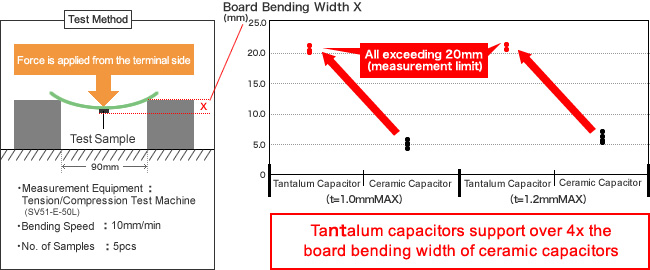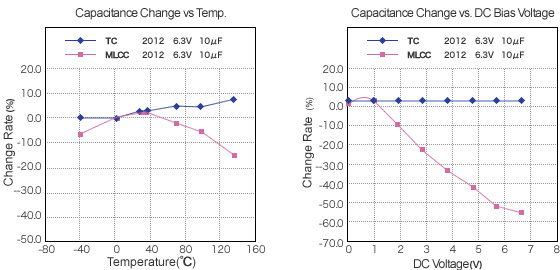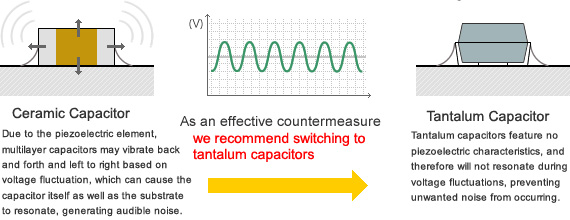tc_what4(Ceramic Capacitor vs Tantalum Capacitor 1)
Ceramic Capacitor vs Tantalum Capacitors
Surface mount tantalum capacitors typically feature a bottom electrode structure
Tantalum capacitors configured with electrodes on the bottom of the package are not susceptible to shorts, even when mounted close together facing each other. This makes it possible to further decrease set thickness to a level that is difficult or impossible to achieve with ceramic capacitors.
| Ceramic Capacitor | Tantalum Capacitor | |
|---|---|---|
| External Appearance | ||
| When Mounted |  If there not enough space between the top and bottom boards, short-circuits can occur between the electrodes or with the ceramic capacitors, wiring, and substrates. If there not enough space between the top and bottom boards, short-circuits can occur between the electrodes or with the ceramic capacitors, wiring, and substrates.  More space is required between the substrates More space is required between the substrates |
 The bottom electrode configuration prevents shorts, even when the board wiring is facing each other. The bottom electrode configuration prevents shorts, even when the board wiring is facing each other.  ROHM tantalum capacitors feature a bottom electrode design which prevents short-circuits - unlike ceramic capacitors with electrodes exposed on 5 sides. ROHM tantalum capacitors feature a bottom electrode design which prevents short-circuits - unlike ceramic capacitors with electrodes exposed on 5 sides. |
| Limits how thin sets can become | Contributes to thinner sets |
The Strength of Tantalum Capacitors
Resin-mold-type tantalum capacitors are typically strong against stress caused by board deflection. In fact, they can be mounted even at the ends of the board which are subjected to extreme deflection, providing added design flexibility. In addition, board handling precautions typically required for ceramic capacitors during assembly are not needed when using tantalum capacitors.

Board Deflection Test (2012 Size Products)
Minimal Variation in Capacitance Characteristics
Tantalum capacitors (TC) experience very little change in capacitance characteristics due to circuit DC voltage and/or temperature fluctuations, eliminating the need to verify the effective capacitance - unlike ceramic capacitors (MLCC).

Capacitance Characteristics
No Sound Problems
In many cases when using ceramic capacitors, audible noise is discovered during final evaluation, which require urgent countermeasures before shipment in order to prevent significant damage from occurring. In contrast, because tantalum capacitors themselves do not resonate, no noise is generated, ensuring worry-free operation.

Capacitor Characteristics
electronics_tips_menu




